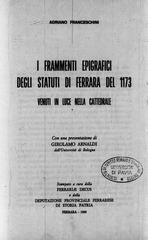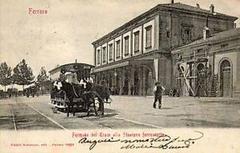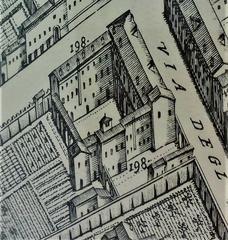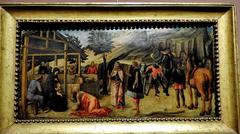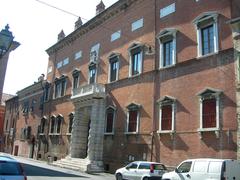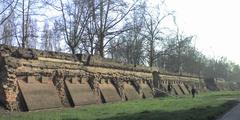Campanile della Cattedrale di Ferrara: Visiting Hours, Tickets, and Travel Guide
Date: 03/07/2025
Introduction
The Campanile della Cattedrale in Ferrara, Italy, is a striking testament to Renaissance artistry and the city’s enduring historical legacy. Adjacent to the Cathedral of San Giorgio Martire, this iconic bell tower dominates Ferrara’s UNESCO-listed historic center, blending architectural beauty, religious significance, and cultural heritage. Built primarily throughout the 15th century, the Campanile reflects the ambitions of the Este family and Ferrara’s Renaissance humanism. Its alternating pink and white marble bands, classical motifs, and finely carved sculptural elements—such as the bust of San Maurelio, Ferrara’s patron saint—make it a must-see for visitors (Ferrara Terra e Acqua, it.wikipedia).
Despite structural challenges—most notably, its unfinished top due to Ferrara’s sandy subsoil—and its survival through World War II and recent seismic events, the Campanile remains a resilient symbol. Ongoing restoration projects aim to preserve this architectural treasure for future generations (La Nuova Ferrara, Il Resto del Carlino).
This guide provides essential information on visiting hours, ticketing, accessibility, restoration updates, and travel tips. It also highlights nearby attractions—such as the Cathedral Museum and Piazza Trento e Trieste—to help you plan a rich and memorable visit (inferrara.it, catholicshrinebasilica.com).
Contents
- Introduction
- Historical Overview
- Architectural Features
- Restoration and Conservation
- Visiting Hours, Tickets, and Accessibility
- Nearby Attractions
- Visitor Experience and Facilities
- Visuals and Photography Tips
- Frequently Asked Questions (FAQ)
- Conclusion and Travel Tips
- Sources
Historical Overview
Origins and Development
The construction of the Campanile began in 1412, continuing throughout the 15th century and culminating in 1493. Its design is attributed to Renaissance architect Leon Battista Alberti, though his direct involvement is debated. The Este family commissioned the bell tower as part of a broader movement to modernize Ferrara’s cathedral and assert the city’s status (it.wikipedia, catholicshrinebasilica.com).
Resilience Through Time
Originally intended to be topped with a spire, the Campanile remains unfinished due to the unstable subsoil. Despite this, it has survived centuries of change, from Renaissance opulence to the bombings of World War II and the 2012 Emilia earthquake (La Nuova Ferrara).
Architectural Features
- Materials: The core is brick, clad in alternating bands of pink and white Verona limestone.
- Decorative Elements: Gray limestone columns from Noriglio, Istrian stone bases, prun stone capitals, and Vicenza stone coats of arms.
- Sculptural Details: The base features 15th-century sculptures of the Evangelists and a renowned bust of San Maurelio by Matteo Castaldi.
- Design: Four distinct levels, articulated by pilasters and cornices, and a deliberately unfinished summit, contributing to its unique silhouette (Ferrara Terra e Acqua).
The Campanile’s Renaissance symmetry, classical motifs, and rich sculptural program reflect Ferrara’s artistic and civic ambitions.
Restoration and Conservation
Current Works and Timeline
A major restoration, begun after the 2012 earthquake, is scheduled for completion by the end of 2025. The focus is on structural stabilization, marble cladding consolidation, and replacement of oxidized metal supports. These efforts are overseen by architect Benedetta Caglioti and structural engineer Professor Claudio Modena, with funding from the Ministry of Culture (La Nuova Ferrara, Il Resto del Carlino, Filomagazine).
A distinctive “mantovana” protective structure has been installed to catch any falling debris during restoration. The campanile’s restoration is integrated with broader conservation of the cathedral complex, including the nave, sacristy, and facades.
Community Impact
Restoration projects have revitalized community engagement with Ferrara’s heritage and have led to the discovery and preservation of medieval capitals and sculptural groups (Teleromagna).
Visiting Hours, Tickets, and Accessibility
Opening Hours
- Cathedral: Daily, 9:00–12:00 and 15:00–18:00 (inferrara.it).
- Campanile: Exterior viewing is always possible. Interior access is generally restricted but may be available during special guided tours or events. Check with the tourism office for up-to-date details.
Admission and Tickets
- Cathedral: Free entry; donations are welcome to support restoration (inferrara.it).
- Campanile: No separate ticket needed for exterior viewing. Special tours may require advance booking or a small fee.
- Cathedral Museum: Entry €6 (reduced €3), open 9:30–13:00 and 15:00–18:00 (closed Mondays).
Accessibility
- The cathedral and its surroundings are accessible. For those with mobility challenges, a safe route is located behind the bell tower.
- Some areas may be restricted during restoration. Contact cathedral staff in advance for assistance: +39 388 3788600.
Nearby Attractions
- Cathedral of San Giorgio Martire: A blend of Romanesque, Gothic, Renaissance, and Baroque styles, featuring major artworks.
- Cathedral Museum: Houses original pieces by Cosmè Tura and Jacopo della Quercia.
- Piazza Trento e Trieste: The city’s lively main square, perfect for views, photography, and relaxing at local cafés.
- Castello Estense: A Renaissance-era fortress just a short walk away.
- Palazzo Municipale: The historic town hall opposite the cathedral.
Visitor Experience and Facilities
Viewing and Tours
- The best views of the Campanile are from Piazza Trento e Trieste.
- Guided tours of the cathedral and museum are available via local tourism agencies.
- Special events (such as FAI Spring Days) may offer rare interior access to the Campanile and Archbishop’s Palace (Filomagazine).
Facilities
- Restrooms: Available near the main square.
- Cafés and Shops: Numerous options surround the cathedral.
- Tourist Information: The Ferrara tourism office provides maps, brochures, and updates.
Visuals and Photography Tips
- The alternating marble bands glow in early morning and late afternoon.
- Alt text suggestions for photos:
- “Campanile della Cattedrale bell tower in Ferrara under blue sky”
- “Renaissance columns on Campanile della Cattedrale, Ferrara”
- “Bust of San Maurelio on Campanile della Cattedrale”
- Photography is encouraged outside. Inside the cathedral, please respect any restrictions and avoid flash.
Frequently Asked Questions (FAQ)
Q: Can I climb the Campanile?
A: Regular public access is not available, but special tours may offer limited interior visits.
Q: Is there a fee to visit the Campanile or Cathedral?
A: Exterior viewing and cathedral entry are free; donations are appreciated. Museum admission is €6 (reduced €3).
Q: Is the site accessible?
A: Yes, with accessible routes and assistance available. Some interior areas may be restricted during restoration.
Q: What are the best times for photography?
A: Early morning and late afternoon provide the best natural light for capturing the Campanile’s marble details.
Conclusion and Travel Tips
The Campanile della Cattedrale is a magnificent symbol of Ferrara’s Renaissance heritage, resilience, and civic pride. From its elegant marble façade to its ongoing restoration, the tower offers a compelling experience for history lovers, architecture enthusiasts, and casual visitors alike. Combine your visit with the adjacent cathedral, museum, and vibrant city square for a complete immersion in Ferrara’s unique atmosphere.
Travel Tips:
- Check the official tourism portal for current hours and restoration updates.
- Visit in spring or autumn for pleasant weather and lighter crowds.
- Consider joining a guided tour for deeper insights and possible special access.
- Support ongoing preservation by making a donation.
For immersive guides and real-time updates, download the Audiala app and follow Ferrara’s cultural channels.
